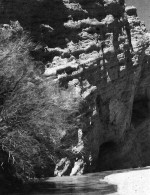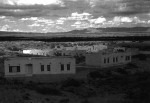Examining Ecosystem Dynamics in a Biome Transition Zone
By Bob Parmenter
Stretching across the Rio Grande from the Sierra Ladrones to the Los Pinos Mountains, the Sevilleta National Wildlife Refuge incorporates nearly 400 square miles of New Mexico grassland, desert, woodland and forest. Established in 1973 as a gift from The Nature Conservancy and the Campbell Family Foundation, the Sevilleta contains representatives of many southwestern ecosystems, including Chihuahuan Desert, Great Plains grassland, Colorado Plateau shrub-steppe, Interior chaparral, Mogollon pinon-juniper woodland, and cottonwood riparian forests and wetlands. While the University of New Mexico’s LTER Program is located primarily at the Sevilleta N\XTR, researchers also utilize areas in Cibola National Forest, Bosque del Apache National Wildlife Refuge, and the Bureau of Land Management’s Sierra Ladrones Wilderness Study Area. These areas further enhance the ecosystem diversity of the research region with the addition of Ponderosa pine forests, mixed-conifer montane forests, and subalpine forests and meadows.
Research Directions
The dominant theme of the Sevilleta LTER Program is to examine long-term changes in ecosystem attributes (e.g., population dynamics of plants and animals, nutrient cycling, hydrology, productivity, species diversity) as a result of both natural and manmade disturbances (e.g., climate changes, grazing, wildfires, droughts, and the “El Niño—Southern Oscillation” (ENSO)). The Sevilleta LTER Program addresses a number of ecological questions, including:
- How do the El Niño/La Nina climate dynamics influence ecological processes, such as nutrient cycling and energy flows, as well as the population abundances and spatial/temporal distributions of plants and animals?
- What effects do climate dynamics have on the species compositions and trophic structures of the various biome types?
- Across the central New Mexico landscape mosaic, are there similar or disproportionate responses among communities in various biome types when subjected to a common, regional climate change (e.g., drought)?
- Are patterns of plant and animal demographics, density! abundance, survivorship, and reproduction associated with habitat-specific variables (e.g., primary production, precipitation, soil moisture, temperature)?
- How does the heterogeneity of habitat mosaics, in concert with their ecotones, influence floral and faunal distributions, and which species might be poised for habitat invasion/retreat following abrupt or long-term climate changes? Through the LTER studies, we hope to increase our understanding of the natural dynamics of ecosystems in the heterogeneous landscape of central New Mexico.
Sevilleta Biodiversity
The size of the area, the heterogeneous topographic and geological features, and the characteristics of a biome transition zone have resulted in a rich diversity of species. At least 104 families, 1,200 species and 208 varieties of plants occur within the study region, and many species are at their distributional limits. For example, 54 plant species terminate their geographic distributions within the Sevilleta NWR. Some of these species represent major life forms and physiologies, such as the C3 perennial grasses. The terrestrial vertebrate fauna includes 89 species of mammals, 353 birds, 58 reptiles, and 15 amphibians. A substantial proportion of these species have a geographic distribution boundary within the region. Reptiles provide the most dramatic example, as 47 of the 58 species end their distributions in the vicinity of the Sevilleta (33 of these are northern limits of desert species). In addition, a high diversity of arthropods, with distinctive habitat-specific assemblages, has been documented on the Sevilleta.
Population Dynamics
Plant and animal populations exhibit varying degrees of response to the wide range of environmental fluctuations on the Sevilleta. The LTER conducts plant and animal population studies from the Rio Grande riparian zone to
the subalpine forests of the Magdalena Mountains. Included in the list of measured taxa are dozens of plant and vertebrate species, and hundreds of arthropod species. Of recent importance has been the LTER’s population data on Sevilleta rodents, which has contributed to the understanding of the rodent-borne Hantavirus disease in the Southwest.
Ecosystem Process Modelling
In the semi-arid regions of New Mexico, water availability is the limiting factor for many ecosystem processes. As a result, the Sevilleta’s modelling emphasis is on the use of mathematical water balance models, which provides a unifying synthesis of the LTER core topics and the various levels of organization studied by the participating investigators. The water balance approach takes advantage of LTER studies on vegetation, soils, climate and precipitation, and incorporates remotely sensed imagery. In addition, LTER scientists are implementing a systems model of the CENTURY class in a geographical context, in which the water balance is driven by the nonequilibrium water model. Thus, the models will provide a synthesis of existing and future data concerning the core areas of organic matter processing, primary production, and inorganic inputs. The synthesis will be of immediate use in relation to the disturbance and population core topics, including vegetation-environment relations, nutrient dynamics, species distributions and abundances, animal population studies, and population genetics. These field and laboratory studies will provide the necessary biological components that represent the contingencies and feedbacks that are both the responses to, and the constraints on, the dynamics of water.
Anthropogenic Disturbances
The Rio Grande valley has been home to human populations for millenia. Having first been occupied 20,000 years ago by Folsom and Clovis Man, a succeeding array of human societies and civilizations have made central New Mexico their homes. Their presence has led to many changes in the landscape, and anthropogenic disturbances continue to be a major influence on the region’s ecology. As a result, studies of natural succession and restoration biology are of particular interest in the region. The grassland and desert shrub areas of most of New Mexico have been heavily grazed for centuries. The Sevilleta region is host to numerous experiments and studies of natural succession and recovery. Species reintroductions also have occurred, such as the native Desert Bighorn Sheep in the Sevilleta’s Sierra Ladrones. The riparian cottonwood forest along the Rio Grande also has been greatly altered by harvesting, river control from impoundments, and invasion by exotics. University of New Mexico and Fish and Wildlife Service ecologists have initiated research programs at Bosque del Apache NXTR that examine aspects of cottonwood forest restoration, focusing particularly on flood manipulations of the Rio Grande and the effects on riparian forest ecosystem processes.
Wildfire Studies
Natural fires have become more common on the grassland areas of the Sevilleta’s protected research areas (no livestock grazing). The studies of both natural and experimental fires show that the influence of fire is very species-specific, because perennial grasses with large, belowground root systems (e.g., blue grama of the Great Plains flora) survive while Chihuahuan Desert species (e.g., black grama, desert shrubs) are depleted. Thus, in the tension zone between Chihuahuan Desert and other biomes, fire may be a primary agent in controlling species movement due to climate dynamics. In areas where the desert species have been established for a longer period (i.e., more like desert habitat than transition habitat), the grass component has been greatly reduced and fires are rare or nonexistent. Factorial fire experiments are underway on the Sevilleta that relate burning and herbivore (large ungulates) activity to plant and animal community composition and ecosystem processes.
Other Studies Opportunities
The Sevilleta NWR and newly constructed Field Station host a total of 105 research projects from 32 universities, 17 government agencies, and eight private organizations. Collaborative research projects with scientists and students from numerous disciplines are encouraged by the Sevilleta LTER, and all interested researchers are invited to contact the LTER for more information on potential interactions.
For more information. Robert R. Parmenter, Department of Biology, University of New Mexico, Albuquerque, NM 87131, 505-277-7619, rParmenter@LTERnet.edu

 Enlarge this image
Enlarge this image
